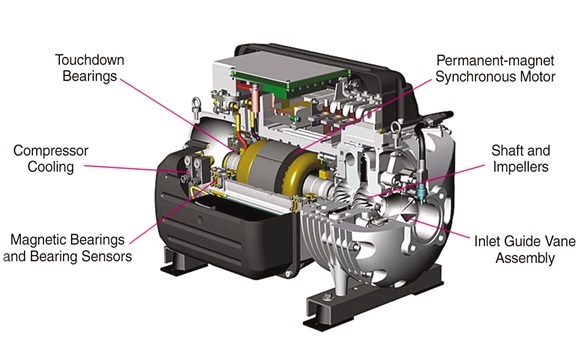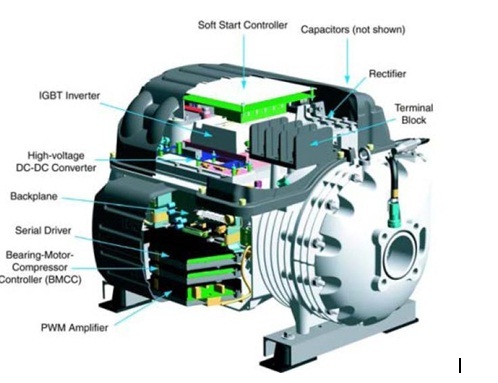





Published on Apr 02, 2024
Magnetic bearing centrifugal compressor eliminates the efficiency-robbing friction inherent in traditional centrifugal chiller. Integrated VFD optimized part load efficiency, a key performance feature since most chillers operate at part load 99% of their life. Sustainable performance assured for the operating life of the chiller.
The positive pressure, oil-free design eliminates performance degradation due to non-condensable and oil contamination of the refrigerant. Easy integration with our open choices feature using BACnet, LonWorks or Modbus communications without an expensive panel.R-134a refrigerant has no depletion potential and no phase=out schedule. Reduced maintenance costs due to elimination of oil.
Oil system, purge system, and shaft seals found in order technology chillers. Small unit footprint helps the magnitude chiller fit in place where space is limited, making it ideal for retrofit projects. Unmatched unloading with the integrated VFDs since the on-board digital control reduce compressor speed to match the load. Low inrush current at start-up is ideal for operation with backup or emergency power systems. Touch screen operator panel is graphically intuitive and easy o use for enhanced operator productivity. Important status and control information is available at a glance or a touch.
Traditional centrifugal compressors use roller bearings and hydrodynamic bearings, both of which consume power and require oil and lubrication system. This can be overcome by the introduction of new compressor technology called frictionless compressor technology.
The frictionless compressor technology is compressor with the application of magnetic bearings and permanent magnet synchronous motor. In frictionless compressor instead of roller bearings and hydrodynamic bearings, magnetic bearings are used. Magnetic bearings consume less power and there is no need for oil and lubrication systems. Permanent magnet brushless synchronous motor has permanent magnet instead of copper windings.
After 10 years of development, magnetic bearing compressors offer economic, energy, and environmental benefits. Chief among them are increased energy efficiency, the elimination of oil and oil management and considerable less weight, noise, and vibration. This is initial mid-range package offers centrifugal compression efficiencies previously reserved for large tonnage systems only.
This compressor has high reliability, efficiency, less maintenance cost and staff. With the help of digital control system the controlling and monitoring of work is very easy. The frictionless compressor technology makes newrevolutions in the field of air conditioning, refrigeration etc. Frictionless Compressor Technology is one of the fast growing Technology in the engineering field.
The Frictionless compressor is also the world’s first totally Oil-Free compressor specifically designed for the Heating, Ventilation, Air Conditioning and Refrigeration (HVACR) industry. The variable-speed centrifugal compression and digital electronic technologies enables the frictionless compressors (nominal 60-150 ton capacity range) to achieve the highest compressor efficiencies, cost effectively, for middle-market, water-cooled, evaporative cooled and air-cooled HVACR applications. The well-proven energy performance advantages of variable-speed centrifugal
Compressors are now brought to mainstream middle-market applications through the use of High-speed, two-stage centrifugal compression with integral variable-speed drive. Compressor speed is reduced as the condensing temperature and/or heat load reduces, Optimizing energy performance through the entire operating range from 100% to 20% or below of rated capacity.
Operations to near zero loads are achievable via an optional, digitally controlled, load balancing valve. Centrifugal compressors tend to be more efficient than screw or scroll Compressors, and take advantage of speed control more effectively, but they are usually onlyavailablein largersizes. By using the smaller shaft, they are able to take advantage of thecentrifugal compressor technology in a smaller size than is normally available.

Composed of both permanent and electromagnets
Enables precisely controlled frictionless compressorshaft rotation on a levitated magnetic cushion
Bearing sensors, located at each magnetic bearing, feedback rotor orbit and thrust/axialinformation in real time tobearing control
Carbon-lined radially and axially located bearings supportthe rotor when the compressor isnot energized
Prevents contact between the rotor and othermetallic surfaces
Only one major moving compressor component
Acts as rotor for permanent-magnet synchronous motor
Impellers are keyed directly to the motor rotor

What is the difference between ABS & Traction Control?
• ABS
Manage the grip of the tires for braking maneuver
• Traction Control
Manage the grip of the tires for accelerating maneuver.
Magnetic-bearing technology is significantly different. A digitally controlled magnetic-bearing system, consisting of both permanent magnets and electromagnets, replaces conventional lubricated bearings. The frictionless compressor shaft is the compressor’s only moving component. It rotates on a levitated magnetic cushion. Magnetic bearings—two radial and one axial—hold the shaft in position (Figure 2). When the magnetic bearings are energized, the motor and impellers, which are keyed directly to the magnetic shaft, levitate. Permanent magnetic bearings do the primary work, while digitally controlled electromagnets provide the fine positioning. Four positioning signals per bearing hold the levitated assembly to a tolerance of 0.00002 in.
As the levitated assembly moves from the center point, the electromagnets’ intensity is adjusted to correct the position. These adjustments occur 6 million times a minute. The software has been designed to automatically compensate for any out-of-balance condition in the levitated assembly. The rotor shaft’s position is held by front and rear electro-magnetic cushions. The shafts position is monitored with 10 sensors that send a signal to a digital controller which then sends a command to the 5 separate pulse width modulators (PWM), for a proper shaft repositioning
When the compressor is not running, the shaft assembly rests on graphite-lined, radially located touchdown bearings. The magnetic bearings normally position the rotor in the proper location, preventing contact between the rotor and other metallic surfaces. If the magnetic bearings fail, the touchdown bearings (also known as backup bearings) are used to prevent a compressor failure. The compressor uses capacitors to smooth ripples in the DC link in the motor drive. Instantaneously after a power failure, the motor becomes a “generator,” using its angular momentum to create electricity (sometimes known as back EMF) and keeping the capacitors charged during the brief coast down period.
The capacitors, in turn, provide enough power to maintain levitation during coast down; allowing the motor rotor to stop and DE levitate. This feature allows the compressor to see a power outage as a normal shutdown.In case of power failure, within 0.5 micro-seconds, the motor acts as a generator for the magnetic bearings and the compressor comes gradually to a complete stop; the rotor de-levitates normally unto backup bearings.
| Are you interested in this topic.Then mail to us immediately to get the full report.
email :- contactv2@gmail.com |